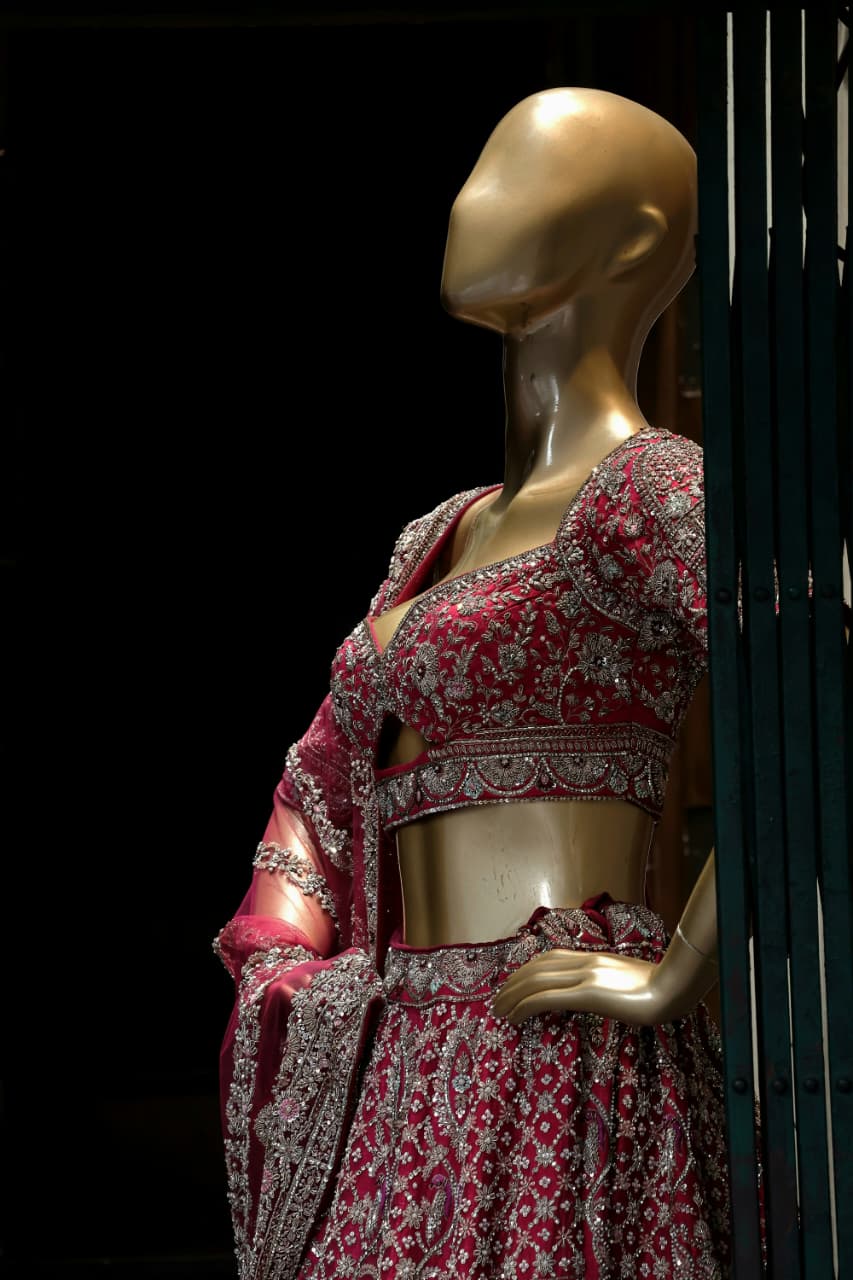
Up until the mid-90s, bridal outfits usually meant the traditional red saris in jamdani, muslin or silk, especially for the main biye event. As globalisation opened us up to a world of inspiration, with Bollywood trends dominating, the early 2000s began to see a shift in demand for different options for bridal wear. Exposure to the elaborate couture confections concocted by Indian designers such as those of Sabyasachi and Manish Malhotra, began shifting local preferences. Brides started exploring lehenga cholis, shararas, and anarkalis, drawn to their sculpted silhouettes and layered textures. Dhaka’s boutiques and designers rose to the challenge and began offering localised versions of these looks, merging them with Bangladeshi embroidery techniques like karchupi and zardozi to create a nuanced design dialogue that changed the trajectory of local bridal wear forever.
The local fashion industry evolved to meet the rising demand for personalised bridal wear. In the early 2000s, most brides relied on family tailors or Dhaka New Market shops to reproduce catalogue looks. But as design tastes became more sophisticated, couture-style studios began to emerge in Gulshan and Dhanmondi, offering design consultations, fabric sourcing, and bespoke fittings.
Designers like Rina Latif, Maheen Khan (Mayasir), and Lipi Khandaker (Bibiana) were among the first to translate global bridal trends through a Bangladeshi lens, blending modern cuts with traditional materials like silk, muslin, and jamdani. Their work helped define the aesthetic of contemporary Dhaka couture, refined for contemporary tastes, yet deeply rooted in traditional values.
By the mid-2010s, this fusion became mainstream. Some brides wore Benaroshi-inspired lehengas, or gowns with jamdani panels. Others layered dupatta-style veils over saris for a hybrid aesthetic. The influences were coming in from all over the world at this point. The emphasis moved from strictly traditional to personalised elegance, keeping cultural roots intact while embracing global bridal trends.
In an interview with Fariha Tashmeen Tinny, the designer and founder of the label Viola by Fariha, she talks about her experience of designing her own wedding lehenga in the 2010’s. “Making my own outfit was a challenge because I had just started the bridal line, so I was new to it, and understandably nervous, but I told myself that no one understands my body and my preferences better than me. I’m a petite woman, so I selected an A-line silhouette that would create the illusion of height and curves. I added just a touch of volume to the bottom for that fairy-tale flair, careful not to go for too much flare, which would overwhelm my height. This is a style that flatters just about any size or shape, and is easy to move around in. I selected peach and gold with zardosi on the bodice, and lots of stones, sequins and mirror work to really channel the fairytale glitter. I balanced it with lace frills at the bottom, and topped it off with a gold dupatta with minimal work. The result was a glamourous, but elegant outfit – just the way I wanted it. Making my own wedding dress, gave me the deep understanding of how important this day can be for a bride and her family, and how a wedding dress can leave a lasting imprint on the whole event and thereafter”.
And once social media entered the chat, all bets were off. Today’s deshi bride puts a premium on individual expression, and as the woman of the hour, the right outfit is central to the story she wants to tell the world. Instagram and Facebook turned local designers into brands, with brides using digital mood boards to communicate their vision. Studios like Tanzim Tisha, Nipun, Anik Khan, Humaira Khan, and Tanjim Rahman began offering full-scale bridal collections alongside made-to-measure services.
One result of this expansion was that it also revived traditional craftsmanship. The renewed interest in hand embroidery, karchupi, zardozi, and gota work created a steady demand for skilled artisans, many of whom operate in small workshops across Old Dhaka, Narayanganj, and Tangail. In many ways, the custom bridal wear boom has sustained these crafts, giving them relevance in a modern fashion economy, although detractors argue that the hefty price tags of the finished product make it more cost-effective to go to India for trousseau-shopping, thus driving the demand overseas, while artisans at home struggle to eke out a living.
Designer Sumaya Khan talks about the labour of love that goes behind custom creations. “For me luxury fashion is slow fashion, each outfits take around 160 hours of labour and hence I want to see my customers re-wear these outfits even after 10 years and still look fashionable. We must learn to appreciate and love our unique luxury outfits; they are no less than pieces of fine art”.
The digital revolution has not overlooked the wedding wear industry. In 2022, the fashion brand Festivibe launched their Virtual Design Consultant which allowed consumers to mix, match, and customise their looks online from the comfort of their own homes.
As fashion evolves, our local designers and artisans continue to adapt to continue the dialogue. Today’s Bangladeshi bridal wear sits at the intersection of heritage and reinvention. Each piece reflects where we’ve come from and how far we’re willing to go to make tradition our own.
